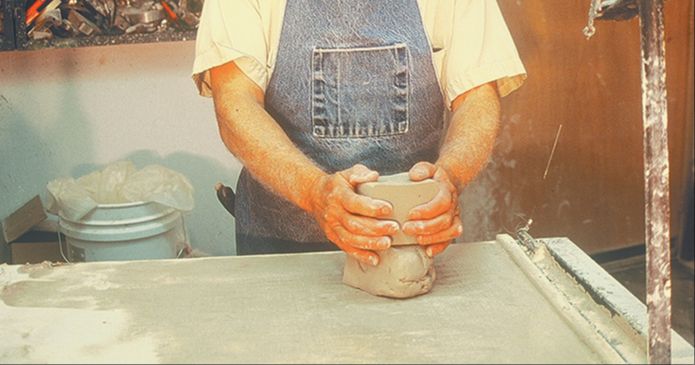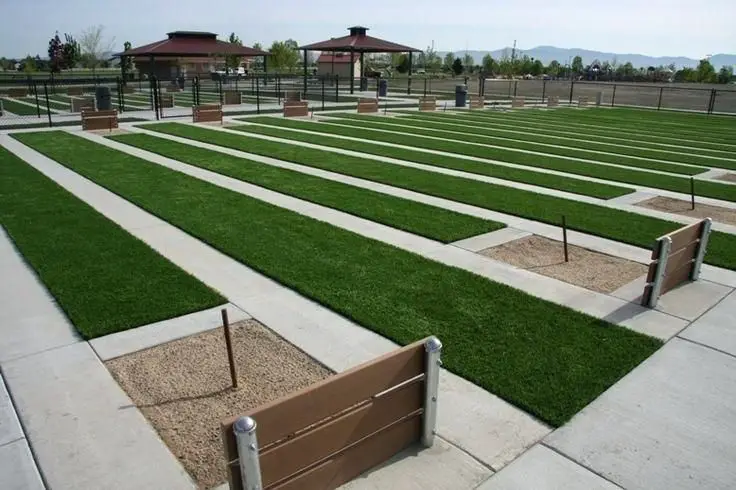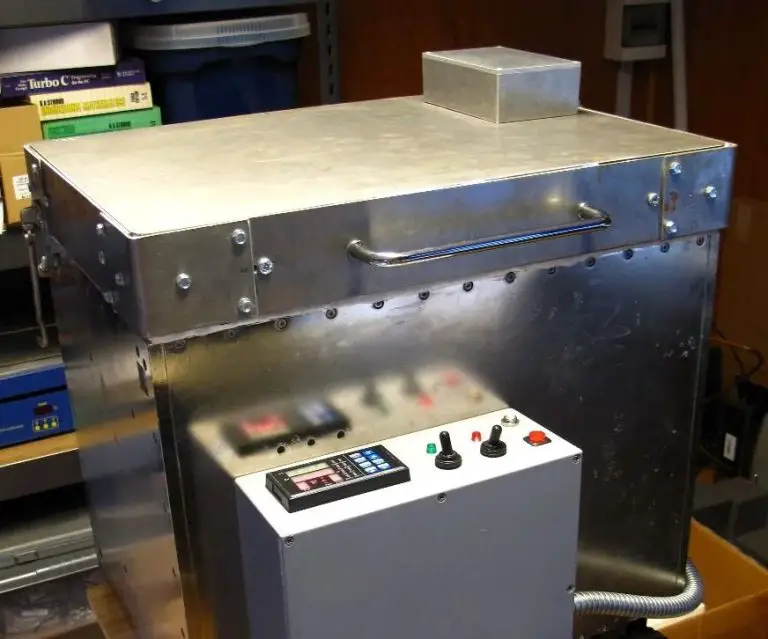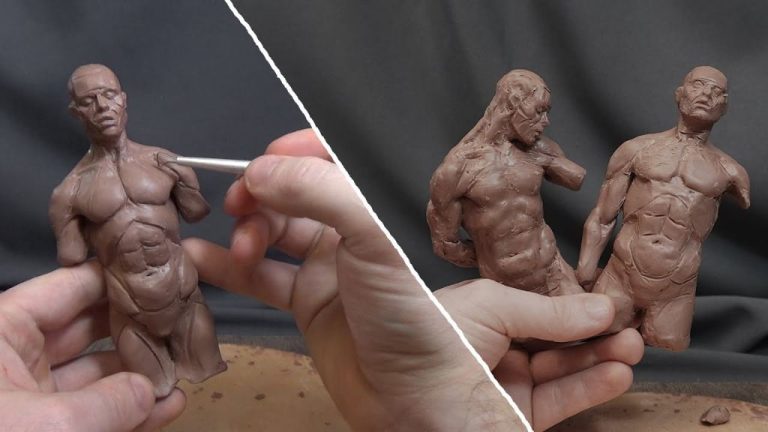Is Hand Building Or Wheel Throwing Easier?
Ceramic arts involve two main techniques for creating pottery or sculpture – hand building and wheel throwing. Hand building involves constructing clay works by hand, using techniques like pinching, coiling, slab building, and sculpting. Wheel throwing involves throwing clay on a pottery wheel and manipulating it into different shapes while it spins. Both hand building and wheel throwing have been used for thousands of years in pottery and ceramic arts. They each have their own unique benefits and challenges. This article examines the key differences between hand building and wheel throwing techniques for beginners interested in getting started with ceramic arts.
Defining Handbuilding
Handbuilding refers to forming pottery using only your hands, without the use of a potter’s wheel. The three main techniques in handbuilding are pinch pots, coil building, and slab construction. Pinch pots involve pinching and pulling the clay to form a basic pot shape. Coil building involves rolling out ‘snakes’ of clay into coils, then stacking the coils to build up the walls of a pot. Slab construction involves rolling out flat ‘slabs’ of clay that can be cut into shapes and assembled into box-like forms or vessels.
Some key advantages of handbuilding include being able to make asymmetric and irregular shapes that are difficult on the wheel. It also does not require the dexterity and centrifugal force needed for throwing. Handbuilding gives more direct contact with the clay. Beginners also find handbuilding to be more accessible when first learning clay. The Crucible provides an excellent overview of the basic handbuilding techniques and projects.
Defining Wheel Throwing
Wheel throwing is a pottery technique that involves using a potter’s wheel to shape clay into forms like cylinders, bowls, and vases. The process begins by centering a lump of clay on the wheel and then using your hands, fingers, and tools to manipulate the rotating clay. According to The Crucible’s guide, the basic steps involve sealing the clay to the wheel’s bat, centering the clay, opening the clay, and then carefully shaping the desired form as the wheel spins at a consistent speed.
Wheel throwing requires a combination of coordination, muscle memory, and finesse to center the clay and shape symmetrical forms. As noted by Soul Ceramics, it’s important to use just enough water to keep the piece moving smoothly on the wheel. Over time, potters develop muscle memory through repetition and practice to perfect their technique and throw increasingly complex forms.
Some common wheel thrown vessels include cylinders, bowls, plates, vases, pitchers, teapots, cups, and lidded jars. The rotational momentum allows potters to shape and refine vertical forms that would be very difficult to make solely by handbuilding techniques.
Learning Curve
When it comes to the learning curve, both handbuilding and wheel throwing require time and practice to master. However, most potters agree that handbuilding tends to be easier for complete beginners to pick up initially.
Wheel throwing involves coordinating your hands, feet, and overall body movements to center the clay and raise the walls of a pot. This process requires developing muscle memory and a sensitivity to the clay, which can take months of practice to control properly. According to ceramic artist and teacher source, wheel throwing has a steep initial learning curve, and new students should expect many failed attempts when starting out.
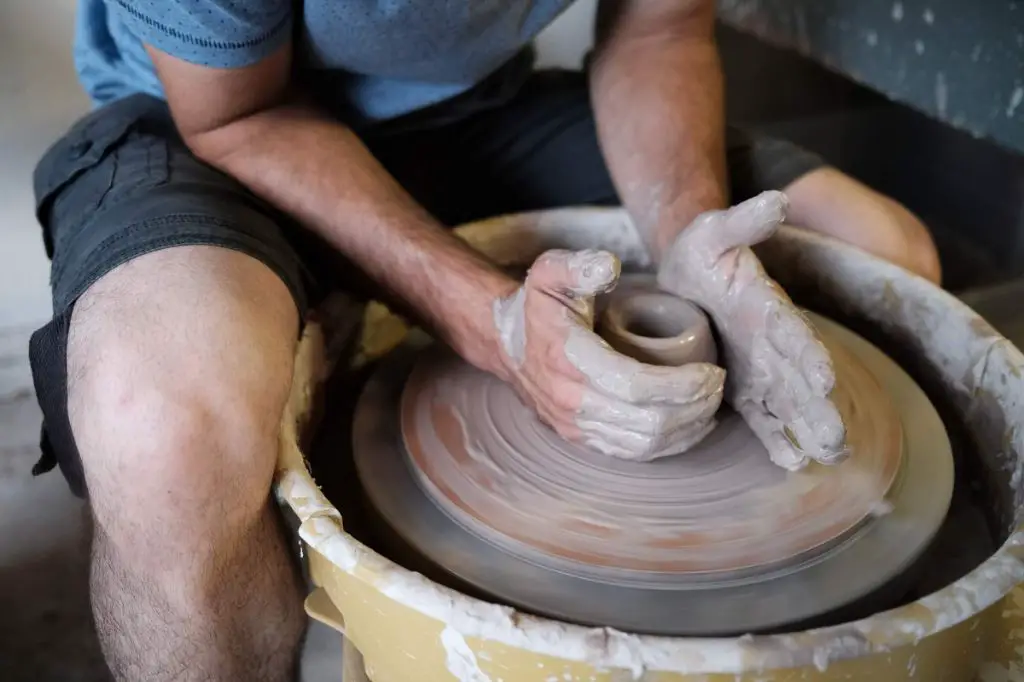
In contrast, handbuilding allows you to work at your own pace without relying on the centrifugal force of a spinning wheel. Techniques like pinch pots, coils, and slabs give you more direct control to shape the clay into freeform sculptures or functional wares. While mastery still requires time, the basic handbuilding processes can be picked up in a matter of hours or days according to most ceramic instructors.
In summary, handbuilding tends to be more accessible and have an easier initial learning curve for complete beginners. However, both methods require extensive practice over months or years to gain proficiency. Wheel throwing may have a steeper initial challenge, but many potters find the skills incredibly rewarding to develop.
Required Tools
The basic tools needed for handbuilding include:
– Cutting tools like fettling knives, loop tools, and ribbon tools for cutting, smoothing, and shaping the clay (A Beginning Hand Builder’s Toolbox).
– Texture tools like stamps, rollers, and carving tools for adding decorative effects (A Beginning Hand Builder’s Toolbox).
– Modeling tools like ribs and wooden sticks for smoothing, burnishing, and shaping the clay.
– Bats or canvases to work on.
The basic tools needed for wheel throwing include:
– A potter’s wheel.
– Throwing tools like ribs, trimming tools, loop tools, and needle tools for centering, lifting, cutting, and smoothing the clay (A Beginning Wheel Thrower’s Toolbox).
– Bats for throwing and trimming work.
– Modeling tools like wooden ribs and metal scrapers.
– Cutting tools like wire tools and fettling knives.
Control & Precision
When it comes to control and precision, there are tradeoffs between handbuilding and wheel throwing. Wheel throwing allows for very precise control in shaping symmetrical forms. The spinning momentum of the wheel makes it easier to center clay and raise uniform walls. Experienced throwers can create pieces with thin, delicate walls that would be difficult to achieve with handbuilding. As ceramic artist Lindsay Oesterritter notes, “The wheel enables more consistency and control in your pieces. You can throw multiple pieces that are the same – mugs, bowls, plates, etc. – much easier than you can handbuild multiples.” (Source)
Handbuilding, on the other hand, offers more creative freedom and control over organic, asymmetrical, or intricate forms. Since pieces are built by hand, there is unlimited potential for shaping the clay exactly how you envision. You don’t rely on the momentum of a wheel, allowing total control over every curve, angle and texture. As ceramic artist Emily Reason states, “I prefer handbuilding over throwing because I have more control. The clay is completely at my command at all times.” (Source) With practice, handbuilders can also achieve uniformity in their work. However, extreme precision in walls and symmetry takes more time and skill without the aid of a wheel.
Creativity & Expression
Both handbuilding and wheel throwing allow for immense creative expression in ceramics. With handbuilding, artists can shape clay into anything imaginable using techniques like pinch pots, slabs, coils, and more. As one article states, “Handbuilding techniques allow you to make ceramic pieces of any shape or size – the possibilities are endless.” (Source)
Wheel throwing also offers creative possibilities through centering clay on the wheel and manipulating it into symmetrical forms like bowls, vases, cups, and plates. As described in an insightful article, “The thing about throwing is that there are days when you might be able to crank out four or five pots in a single class period, and on other days, you struggle to center even a single lump of clay. But it’s addictively satisfying when you do manage to throw a nice pot.” (Source)
Both methods allow artists to express their creativity through clay in unique ways. Handbuilding offers freedom in organic shaping, while wheel throwing enables symmetrical forming. With practice and experimentation, ceramists can unlock their creative potential through either approach.
Complexity
Both handbuilding and wheel throwing allow potters to create simple forms, like bowls and cups. However, when it comes to complex shapes and intricate details, handbuilding has a clear advantage. With handbuilding techniques like coils, slabs, and pinching, artists can take their time to sculpt creative forms not possible on the pottery wheel. As one potter explains, “Handbuilding is unparalleled for making complex sculptural forms, refined details, textures and connecting disparate parts” (source). Wheel throwing requires symmetry and centering, limiting what shapes can emerge. While skilled throwers develop techniques to alter forms, handbuilding provides direct control to construct multidimensional, asymmetric, and elaborate ceramic art.
Artistic Satisfaction
When it comes to artistic fulfillment, both handbuilding and wheel throwing have their advantages. Many ceramic artists find handbuilding extremely gratifying because of the direct contact it allows with the clay. Handbuilders can shape the clay exactly how they envision, without the restrictions of the wheel. This enables immense creativity and individual expression. As Charlotte Lindley Martin states on her website, “Handbuilding allows me to create more organic forms that I can’t make on the wheel.”
However, wheel throwing also provides great artistic satisfaction through the beauty of seeing forms emerge from a spinning lump of clay. The smooth curves and symmetry achieved on the wheel can be immensely fulfilling. As one Reddit user commented, “There is something magical about centering a lump of clay and bringing it to life.” Wheel throwing enables artists to create multiples of the same form with consistency, allowing refinement over time.
In the end, artistic fulfillment depends entirely on the individual artist and their creative goals. Both handbuilding and wheel throwing enable immense creative potential when mastered. As forms of sculptural expression, neither is inherently more or less artistically satisfying than the other. The fulfillment comes from the artist’s connection to the work.
Conclusion
In summary, both handbuilding and wheel throwing have their advantages and disadvantages when it comes to ease of use for beginners. Handbuilding allows more creativity and control initially, as it is easier to conceptualize and does not require as much skill. However, wheel throwing enables efficiency and consistency once the initial learning curve is overcome. Ultimately, the easier method comes down to personal preference and artistic goals.
For those seeking freeform creativity and more abstract sculptures, handbuilding tends to be the better starting point. The direct contact and flexibility lends itself well to expressive works. In contrast, wheel throwing is better suited for those interested in making functional pottery like bowls, cups, and vases. While it takes practice, the wheel facilitates repetition and precision in shaping.
There is no definitively easier or harder method – both handbuilding and wheel throwing present challenges and rewards. The key is trying both to determine which process aligns better with one’s artistic vision and comfort level at different stages of development. An openness to learning the techniques can enable a potter to leverage the strengths of both handbuilding and wheel throwing.

